|
Ski Mountaineering Race FAQ
|
|
|
|


|
|
What
is a Ski Mountaineering race?
A Ski Mountaineering race is a timed event that follows an
established trail through challenging winter alpine terrain while
passing through a series of checkpoints.
Racers climb and descend under their own power using backcountry
skiing equipment and techniques. |
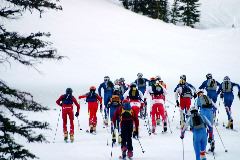 |
|
What
kind of equipment is required?
This may vary with the races, but the mandatory basics will always
be:
-
Avalanche beacon. Must
be working and transmitting on the 457 kHz frequency
-
Shovel. Backcountry
shovels with handles.
-
Avalanche probe or probe poles
-
Ski brakes or leashes (at the ski areas discretion)
Equipment that may be required
(usually for World Cup Events):
-
Sunglasses or goggles
-
Gloves
-
Lightweight jacket
-
Helmet
-
Crampons |
 |
|
How
will I know what equipment is required?
The race organizers will post this information well in advance
(weeks/months) of the actual event.
There will be no surprise equipment requirements the day of the
race. |
|
|
How
much do the races cost to enter?
The races are generally $35 to $50 to enter.
This usually includes the race, the prerace meeting, a t-shirt
and/or items from sponsors and often a post race party.
If the race is held at a ski area, racers will often be required
to purchase a discounted lift ticket.
Depending on the event sponsor, cash or equipment prizes may be
awarded to the top finishers. |
|
|
What
are the courses like?
There will usually be at least two categories per race – a
recreational division and a racing division.
The racing division will be roughly 5,000’ to 6,000’ of
climbing and descents with 3 – 5 climbs involved.
The recreational division will be approximately 3,000’ of
climbing and descents with 2-3 climbs involved.
The racing division will cover approximately 7 – 10 miles with
the recreational division going about 4 – 7 miles. |
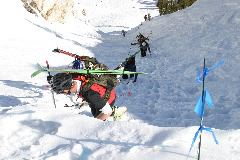 |
|
Where
do the races take place?
In
North America, races generally take place within the boundaries of a ski
area. This is mainly due to
the logistics involved with getting volunteers in place, controlling
avalanche terrain and the issues involved with holding events on public
lands. |
|
|
How
long do the races take?
The fastest times will be around 2 hours for both divisions.
There will often times be a cut off time of 4 – 5 hours. |
 |
|
What
kind of physical shape do I have to be in?
This will depend on the race. In
general, the effort is similar to a half marathon trail running race in
the mountains, both in terms of time and energy. |
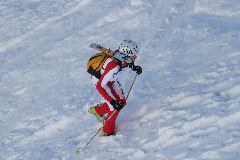 |
|
How
will I know where to go?
The race organizers should post a topographic or schematic map of the
course well in advance of the race as well as hosting a prerace meeting
the night before the race.
The course will be marked with
color coded flagging for the ascent/descents and the checkpoints will be
manned with people who can give you directions to the next checkpoint if
needed. In the event of new
snow, a trail will be broken. |
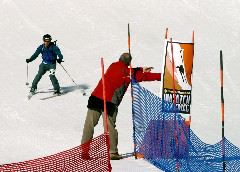 |
|
What
happens at the prerace meeting?
The course details will be discussed, as well as any last minute changes
to the schedule. Racers will
be issued their bibs as well as advised of the forecasted weather.
Liability and insurance forms are usually signed at this time. |
 |
|
Can
I miss the prerace meeting?
Due to travel or logistics, it is often not possible to attend the
prerace meeting. Most often,
if you contact the event organizer prior to the race they will allow you
to pick up your race material the morning of the race, although you will
miss out on the course briefing. |
 |
|
Will
we be traveling in avalanche terrain and should I be concerned about
avalanche danger?
Avalanches and avalanche terrain is an inherent part of Ski
Mountaineering races. The
event organizers will assess the terrain and current snow stability
before starting the race. If
they feel the avalanche danger warrants a change of venue, that will
most likely be announced at the prerace meeting.
Even if the event is held entirely inbounds at a ski resort,
there is always a chance of avalanches and thus avalanche safety
equipment is required (beacons & shovels). |
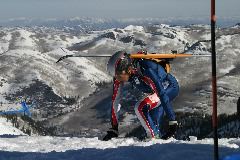 |
|
What
happens if it snows heavily the night before the race or the day of the
race?
The event organizers will either have a back-up course or an altered
version of the course. |
|
|
How
do the starts work?
Roughly one hour before the race starts, racers will be checked for the
required safety equipment and will not be allowed to start without it.
Ten minutes before the start, racers will line up behind a
starting line according to their category.
Depending on the event organizers, racers may start with their
equipment on, or be required to do a
Le Mans
running start. There will be
a five minute warning, then a one minute warning, then a thirty second
warning, after which the starting gun/horn will sound.
The will be no last second count down. |
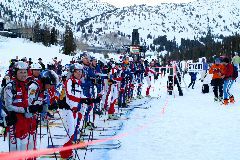 |
|
Can
I have outside assistance during the race?
No. You must finish entirely
under your own power and not receive assistance from other people or
mechanical means. |
|
|
Can
I discard gear along the way and retrieve it later?
No. You must finish will all
the equipment you start with. |
 |
|
Do
I have to follow the marked trail?
The course should be laid out such that it would be slower and
inefficient to deviate from the main track.
Slight variations to pass other racers or climb at a different
angle are acceptable, but you must pass through all checkpoints. |
|
|
What
happens if I can’t finish the race?
If for any reason you can not complete the course, you can
withdraw from the race at any checkpoint or at the finish line by
clearly telling the gatekeeper your name, bib number and that you are
withdrawing. This is important as otherwise a search party may be
sent out for you. |
|
|
What
do I do at checkpoints?
The checkpoints will be manned by volunteers who will be checking
off your number as you pass through.
To make sure you are not missed, you should wear your bib on your
front right thigh and call out your number as you pass through. |
 |
|
Is
any equipment prohibited?
You must ascend using skins or by hiking if specified.
Snowshoes and/or hiking the uphills is not allowed.
Telemark, Alpine Touring and Nordic ski equipment as well as
split snowboards are permitted. Ski
crampons may or may not be allowed and will be stated well in advance. |
|
|
How
do you pass someone on uphill skin tracks?
Ideally, there will be two trails broken which will allow racers to
easily pass. If this is not
the case, the overtaking racer has the right of way but must signal
their intention to pass by clearly stating “Track” to the racer they
are overtaking. It is the
responsibility of the racer who is being passed to let the other racer
by. |
 |
|
Do
races have age or equipment divisions?
This will depend on the race. Most
often it will be Men’s & Women’s divisions within the Racing and
Recreational categories. |
|
|
Is
it possible to get disqualified?
Yes – you can be disqualified for missing a checkpoint or colliding
with the public within a ski area’s boundaries.
It is also possible to be assessed a time penalty for poor
sportsmanship and/or unintentional rule violations, such as littering.
This will be determined by the race officials who will have the
final say. |
|
|
How
are the winners determined?
Places are determined exclusively by order of timed finish.
There are no subjective judged aspects, such as descent style. |
 |
|
What
are the secrets for being fast?
Ski Mountaineering races are a blend of many skills, including
endurance, uphill technique, downhill technique and efficient change-overs.
The uphill portions usually make up the bulk of the race and are
the most important. Maintaining
an even pace throughout the race is a good strategy.
On the descents, avoiding falls while shedding vertical as fast
as possible is vital. While
the change-overs only take a few moments, there can be quite a few of
them and developing a system for switching from skiing to skinning or
visa versa and managing your gear is critical.
Equipment should be as light as possible yet also able to handle
backcountry abuse.
Experienced racers develop a variety of strategies to suit different
courses and conditions. One
of the best of these is to remember that races have many turns of events
and that they are never truly over until you have crossed the finish
line, so it is important to never give up. |
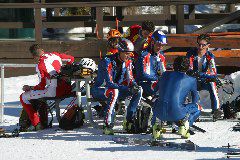 |
|
What
constitutes a World Cup event?
World Cup events are very similar to national races, but adhere to a
strict set of race format rules. World
Cup events must be sanctioned beforehand and the results count towards
overall international standings. To
compete in the World Cup division of a race, you must hold an
International Ski Mountaineering Council (ISMC) competitors license. |
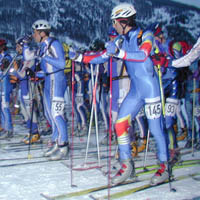 |
|
How
can I get an ISMC / World Cup License?
World Cup Licenses are only required if you are interested in competing
in World Cup events and want to be internationally ranked.
To apply, download the application form here
and follow the instructions.
|
|
|
Is
there any information available about how to host a race?
This will be covered in a separate FAQ. For immediate information,
contact Andrew McLean. |
|
|
Are there any other recommended
websites?
The UIAA has an excellent website that covers ISMC events and
rules. It can be found at http://www.uiaa.ch/index.aspx |
|
|
return to top |
|

















